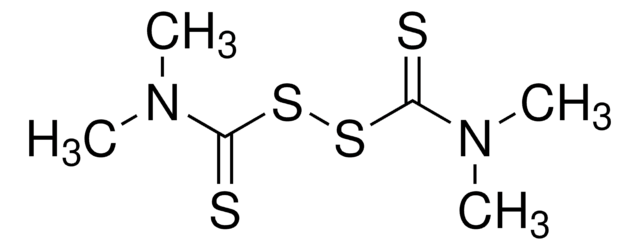All Photos(2)
About This Item
Empirical Formula (Hill Notation):
S
CAS Number:
Molecular Weight:
32.07
MDL number:
UNSPSC Code:
12141912
PubChem Substance ID:
NACRES:
NA.55
Assay:
≥99.0%
form:
powder
Recommended Products
vapor density
8.9 (vs air)
Quality Level
vapor pressure
1 mmHg ( 183.8 °C)
10 mmHg ( 246 °C)
Assay
≥99.0%
form
powder
autoignition temp.
450 °F
resistivity
2E23 μΩ-cm, 20°C
ash
≤3%
pH
6 (20 °C, 10 g/L)
bp
444.7 °C (lit.)
mp
112.8 °C (rhombic) (lit.)
117-120 °C (lit.)
119.0 °C (monoclinic) (lit.)
SMILES string
[S]
InChI
1S/S
InChI key
NINIDFKCEFEMDL-UHFFFAOYSA-N
Looking for similar products? Visit Product Comparison Guide
General description
Sulfur is present in abundant quantities in marine and freshwater sediments. It exists in the form of various sulfur compounds such as pyrite, acid volatile sulfides, elemental sulfur, sulfates and organic sulfur. Quantitative estimation of reduced inorganic sulfur compounds in modern sediments and shales by a chromium reduction technique has been described.
Sulfur is naturally present in cysteine and methionine amino acids, which can be detected by inductively coupled plasma mass spectrometry(ICP-MS). It is also an important element required for plant growth, since it is useful in lowering the pH of the soil.
Sulfur is naturally present in cysteine and methionine amino acids, which can be detected by inductively coupled plasma mass spectrometry(ICP-MS). It is also an important element required for plant growth, since it is useful in lowering the pH of the soil.
Signal Word
Warning
Hazard Statements
Precautionary Statements
Hazard Classifications
Skin Irrit. 2
Storage Class Code
4.1B - Flammable solid hazardous materials
WGK
WGK 1
Flash Point(F)
404.6 °F - closed cup
Flash Point(C)
207 °C - closed cup
Choose from one of the most recent versions:
Already Own This Product?
Find documentation for the products that you have recently purchased in the Document Library.
Customers Also Viewed
Mccarty.B.L et al.
Fundamentals of Turfgrass and Agricultural Chemistry (2003)
Sulfur as the key element for quantitative protein analysis by capillary liquid chromatography coupled to element mass spectrometry
Wind M, et al.
Angewandte Chemie (International Edition in English), 42(29)x`, 3425-3427 (2003)
A Scotto Rosato et al.
Nature communications, 10(1), 5630-5630 (2019-12-12)
The lysosomal calcium channel TRPML1, whose mutations cause the lysosomal storage disorder (LSD) mucolipidosis type IV (MLIV), contributes to upregulate autophagic genes by inducing the nuclear translocation of the transcription factor EB (TFEB). Here we show that TRPML1 activation also
Our team of scientists has experience in all areas of research including Life Science, Material Science, Chemical Synthesis, Chromatography, Analytical and many others.
Contact Technical Service
![2-{2-[(2-Bromo-6-chlorophenyl)amino]phenyl}acetic acid pharmaceutical impurity standard](/deepweb/assets/sigmaaldrich/product/structures/303/197/4983f71e-abfb-4dc7-b1e9-0446b7f2c476/640/4983f71e-abfb-4dc7-b1e9-0446b7f2c476.png)




